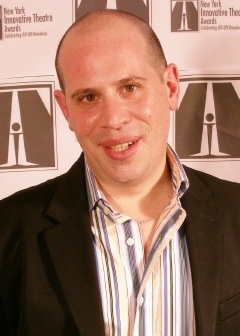New Review: Telephone

For New York Press.
Here's the review:
With This Ring
Telephone is a long distance from reality
Some people in journalism -- and everyone in academia -- consider it lame to mention Wikipedia. I hope I’ll be forgiven in this instance, as the word “disambiguation,” which springs up often on the site and refers to the process by which, say, a computer distinguishes between multiple meanings of the same word by dint of context and syntax, kept coming to mind during Telephone, the new play by poet Ariana Reines produced by the Foundry Theatre.
Directed with a teasing, mildly provocative hand by Ken Rus Schmoll, the play is inspired by Avital Ronell’s The Telephone Book: Technology, Schizophrenia and Electric Speech, a philosophical inquiry into how wire communication disorients and reorients the user. Reines’ conceit is a meditative triptych probing how the same object, the telephone, can be defined differently through time -- thus, “disambiguation.”
It begins with Alexander Graham Bell (Gibson Frazier) and Thomas A.Watson (Matthew Dellapina) appearing in a tableau redolent of the final, frightening moment of a horror film. Their dialogue is circular, and it quickly tests the mettle of the audience as Bell quizzes Watson as to the exact sequence of events that led to the fateful moment the telephone was proven to work. Their banter is jocular and scholarly, but it also has a tone that feels menacing, as if there’s something deeply disconcerting operating beneath it. Together the characters boast a music-hall quality: You expect some top-hat-and-cane action, a little soft-shoe or perhaps a thrilling barbershop trio before their stint on stage is complete.
Notably, Marsha Ginsberg’s set design consists entirely of a freestanding wall with a door. On the wall is the drawing of an owl -- nice metaphorical touch -- and what we are to believe was the first telephone. To give the dialogue energy and thrust, Schmoll directs Frazier and Dellapina to amble around the wall but at all times seemingly arbitrarily and without motivation; it’s as if we are to be prevented from developing a concrete sense as to where we are or what may have called these dotty men back to the room where history was made. Indeed, the actors are ordered, together or separately, to vanish behind the wall entirely for brief periods, as if they’re in a constant state of suspended inanimation. A dull, throbbing dramatic entropy descends as Bell and Watson indulge in cant -- or was it Kant? But at least their chatter has a theme, a thread. In the darkness between the first and second scene, the wall rises. When the lights return, Miss St. (Birgit Huppuch) -- yes, the same curious schizophrenic treated by Carl Jung, who believed she had a telephone inside of her -- is standing atop the table where the mockup telephone had been, and now Bell and Watson have gone behind the wall for good. What follows now is a monologue of colossal proportions: 20 minutes, if I had to make a guess, although it felt like 30 and might easily have been 15. What Miss St. says is genuinely unremarkable but for the fact that it’s a fugue for tin cans and a string. Just imagine everything a late 19th-century telephone operator might have heard in her ear during a month of work, reorganized and laid out as an unceasing assault of verbiage.
Huppuch, just to make it clear, indeed had to memorize this barrage of blather, so that bravura fear is what the scene finally becomes about. Bedecked in Carol Bailey’s Victorian-style dress (I’d have given her a bigger bustle), Huppuch intakes tremendous breaths like desperate, heaving gasps, and simply surrenders to the illogic of the words, managing to render moments of light and shade, of comedy and tragedy, inlaid with lots of irony as she just plows right through it. As an example of acting technique, it’s remarkably well done. The problem is that we intuit the point of the scene about midway through, and a language monsoon can only enthrall and dowse you for only so long. Also, does the telephone make people schizophrenic? While we ponder that, it’s time for the capstone on the evening. Between the second and third scenes, the freestanding wall has been raised so it hangs perhaps seven or eight feet horizontally above the stage. In an example of lighting designer Tyler Micoleau’s inventiveness in the intimate confines of the Cherry Lane Theatre, the final scene consists of dimly lit tableaux that features all three of the actors. Overhead is heard a series of interlocking cell-phone calls in which people profess their love -- or become highly needy about doing so. It is, at last, a 21st-century moment, with all the non-drama you can imagine.
Schmoll doesn’t ask the actors to gaze at their navels during this sequence, but given that we can only discern mild shadows and poses, we wouldn’t know it if they did. I’d offer an analysis of what the final scene means, but call waiting just clicked in. Bye.

No comments:
Post a Comment